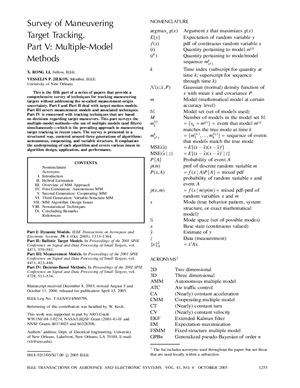This is the fifth part of a series of papers that provide a
comprehensive survey of techniques for tracking maneuvering targets
without addressing the so-called measurement-origin uncertainty.
Part I and Part II deal with target motion models. Part III covers
measurement models and associated techniques. Part IV is conceed
with tracking techniques that are based on decisions regarding
target maneuvers. This part surveys the multiple-model methods–the
use of multiple models (and filters) simultaneously–which is the
prevailing approach to maneuvering
target tracking in recent years. The survey is presented in a structured way, centered around three generations of algorithms: autonomous, cooperating, and variable structure. It emphasizes
the underpinning of each algorithm and covers various issues in algorithm design, application, and performance.
target tracking in recent years. The survey is presented in a structured way, centered around three generations of algorithms: autonomous, cooperating, and variable structure. It emphasizes
the underpinning of each algorithm and covers various issues in algorithm design, application, and performance.

